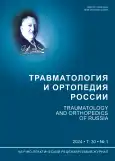Пластика сухожилия глубокого сгибателя как повторное вмешательство после неуспешного лечения повреждений в области пальцев кисти
- Авторы: Мигулева И.Ю.1,2, Файн А.М.1,3
-
Учреждения:
- ГБУЗ «Научно-исследовательский институт скорой помощи им. Н.В. Склифосовского Департамента здравоохранения г. Москвы»
- ГБУЗ «Городская клиническая больница № 29 им. Н.Э. Баумана Департамента здравоохранения г. Москвы»
- ФГБОУ ВО «Московский государственный медико-стоматологический университет им. А.И. Евдокимова» Минздрава России
- Выпуск: Том 30, № 1 (2024)
- Страницы: 5-13
- Раздел: КЛИНИЧЕСКИЕ ИССЛЕДОВАНИЯ
- URL: https://journal-vniispk.ru/2311-2905/article/view/255299
- DOI: https://doi.org/10.17816/2311-2905-12236
- ID: 255299
Цитировать
Аннотация
Актуальность. По данным литературы, частота повторных оперативных вмешательств на сухожилиях сгибателей при повреждениях в области фиброзно-синовиальных каналов составляет около 20% и не имеет тенденции к снижению, но функциональные результаты этих повторных операций и их возможности практически не изучены.
Цель исследования — оценить результаты пластики сухожилия глубокого сгибателя пальцев и длинного сгибателя I пальца у пациентов, которые ранее перенесли неуспешные восстановительные операции по поводу повреждения сухожилий в области фиброзно-синовиальных каналов пальцев кисти.
Материал и методы. Были проанализированы функциональные результаты пластики сухожилия глубокого сгибателя пальцев и длинного сгибателя I пальца у 109 пациентов на 122 пальцах в зависимости от двух факторов — характера первого неуспешного вмешательства на сухожилиях (шов в 51 случае и пластика в 71 случае) и типа стационара, где оно было выполнено (в специализированных отделениях кисти в 76 случаях и в травматологических отделениях — в 46 случаях).
Результаты. Повторные операции после неуспешного шва сухожилий и неуспешной пластики принесли отличные результаты в 13 случаях из 51 (25,5% [95% ДИ: 14–40]) и в 32 случаях из 71 (45,1% [95% ДИ: 33–57]) соответственно, различие статистически значимо (÷2 = 4,888; p = 0,027). После предыдущих неуспешных операций в специализированных отделениях травмы кисти наши повторные вмешательства привели к отличным результатам в 48,7% [95% ДИ: 37–60] случаев (в 37 из 76), к посредственным — в 14,5% [95% ДИ: 7–24] (в 11 случаях из 76). В тех случаях, когда предыдущее неуспешное хирургическое лечение проводилось в неспециализированных стационарах, отличные результаты после повторных вмешательств составили 17,4% [95% ДИ: 8–31], посредственные — в 34,8% [95% ДИ: 21–50] (8 из 46). Эти различия с группой пациентов, которым первая неуспешная операция была проведена в специализированном отделении травмы кисти, были статистически значимы ÷2 = 12,054; p = 0,001. В общей сложности отличные результаты получены в 36,9% [95% ДИ: 28–46] случаев (в 45 из 122), хорошие — в 34,5% [95% ДИ: 26–43] случаев (в 42 из 122).
Заключение. Анализ функциональных результатов пластики сухожилия глубокого сгибателя пальцев и длинного сгибателя I пальца, выполненной как повторное вмешательство, показал, что у пациентов, ранее перенесших неуспешные попытки восстановления сухожилий сгибателей во 2-й зоне, достижение отличных результатов с полной функцией пальцев возможно. Но в целом показатели восстановления движений оказались значительно ниже, чем в неосложненных случаях, даже при большой давности повреждения. Самые низкие функциональные результаты повторных операций оказались у пациентов, прежде неуспешно оперированных в неспециализированных лечебных учреждениях.
Полный текст
Открыть статью на сайте журналаОб авторах
Ирина Юрьевна Мигулева
ГБУЗ «Научно-исследовательский институт скорой помощи им. Н.В. Склифосовского Департамента здравоохранения г. Москвы»; ГБУЗ «Городская клиническая больница № 29 им. Н.Э. Баумана Департамента здравоохранения г. Москвы»
Автор, ответственный за переписку.
Email: MigulevaIY1@zdrav.mos.ru
ORCID iD: 0000-0002-6894-1427
д-р мед. наук
Россия, Москва; МоскваАлексей Максимович Файн
ГБУЗ «Научно-исследовательский институт скорой помощи им. Н.В. Склифосовского Департамента здравоохранения г. Москвы»; ФГБОУ ВО «Московский государственный медико-стоматологический университет им. А.И. Евдокимова» Минздрава России
Email: fainam@sklif.mos.ru
ORCID iD: 0000-0001-8616-920X
д-р мед. наук
Россия, Москва; МоскваСписок литературы
- Dy C.J., Daluiski A., Do H.T., Hernandez-Soria A., Marx R., Lyman S. The epidemiology of reoperation after flexor tendon repair. J Hand Surg Am. 2012; 37(5):919-924. https://doi.org/10.1016/j.jhsa.2012.02.003.
- Svingen J., Wiig M., Turesson Ch., Farnebo S., Arner M. Risk factors for reoperation after flexor tendon repair: a registry study. J Hand Surgery Eur Vol. 2022; 47(10):1071–1076. https://doi.org/10.1177/17531934221101563.
- Lalchandani G.R., Halvorson R.T., Zhang A.L. Lattanza L.L., Immerman I. Patient outcomes and costs after isolated flexor tendon repairs of the hand. J Hand Ther. 2021. https://doi.org/10.1016/j.jht.2021.04.015.
- Giuffrida A.Y., Wolfe S. Options for Failed Flexor Tendon Surgery. In: Duncan S.F.M., ed. Reoperative Hand Surgery. New York, NY: Springer Science+Business Media, LLC 2012. pp. 17-42.
- Elliot D., Giesen T. Treatment of unfavorable results of flexor tendon surgery: Ruptured repairs, tethered repairs and pulley incompetence. Indian J Plast Surg. 2013; 46(3):458-471. https://doi.org/10.4103/0970-0358.121931.
- Elliot D., Giesen T. Treatment of unfavorable results of flexor tendon surgery: Skin deficiencies. Indian J Plast Surg. 2013; 46(2):325-332. https://doi.org/10.4103/0970-0358.118611.
- Honner R., Meares A. A review of 100 flexor-tendon reconstructions with prosthesis. Hand. 1977; 9:226-231. https://doi.org/10.1016/s0072-968x(77)80106-x.
- Miguleva I., Fain A. It is never late to perform flexor tendon reconstruction for zone 2 injuries. In: Building Bridges – Together Hand in Hand: 14th IFSSH &11th IFSHT Triennial congress combined FESSH congress (Berlin, Germany, 17–21 June 2019): abstract book. Berlin, Germany, 2019. pp. 322.
- Sakellarides H. The treatment of scarring and flexion contracture after operations for injuries to the flexor tendons of the fingers by implantation of a silicone rod and tendon grafting. Int Orthop. 1981; 5(3):225-228. https://doi.org/10.1007/BF00266687.
- Dowd M.B., Figus A., Harris S.B., Southgate C.M., Foster A.J., Elliot D. The results of immediate re-repair of zone 1 and 2 primary flexor tendon repairs which rupture. J Hand Surgery Eur Vol. 2006; 31B(5):507–513. https://doi.org/10.1016/j.jhsb.2006.06.006.
- Elliot D., Giesen T. Avoidance of unfavourable results following primary flexor tendon surgery. Indian J Plast Surg. 2013; 46(2):312-324. https://doi.org/10.4103/0970-0358.118610.
Дополнительные файлы









